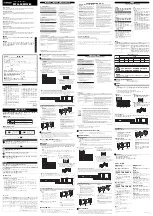
Issue/Rev. 0.4 (6/17) ║ MN03010 • Page 7
Step 8:
Preset a small batch and after high flow is reached, initiate an emergency
stop ('E' Stop). Record the volume throughput after initiation of the 'E' Stop and
observe whether there was excessive line shock. If line shock was excessive, close
the upstream solenoid isolation needle valve a little further to slow the valve closure
rate. Repeat this step until excessive line shock is eliminated.
Step 9:
If possible, with all other loading positions from the pump open (lowest valve
inlet pressure), preset a small batch and run. If opening speed is not acceptable,
open the downstream solenoid isolation needle valve a little further and observe nor-
mal valve opening and closing performance, as done in Steps 6 and 7 (See Note A).
Repeat this step until acceptable opening speed is obtained.
Step 10:
If closing speed is unacceptable, adjust the first stage trip value in the pre-
set counter to a value sufficient to assure reaching final step flow prior to the final
stage trip on the preset counter (See Note B).
Step 11:
Conduct an 'E' Stop test as in Step 8. If the volume throughput after initia-
tion of 'E' Stop is greater than the volume left in the tank or compartment after a high
level sensor initiates an 'E' Stop (typically about twenty (20) gallons for a gasoline
transport), a decision must be made whether to speed up the valve closure and
accept some line shock at high valve inlet pressure (i.e., one load position operating),
or accept a slower than ideal valve closure on 'E' Stop at low valve inlet pressure
(i.e., all load positions operating).
Step 12:
If a modulating pressure pilot was supplied on the valve, it should have
been factory set for the specified control pressure (e.g., 64A pilot set at 35 psi maxi-
mum valve outlet pressure or 23 BP pilot set at 15 psi minimum valve inlet pressure).
Open the isolation needle valve(s) on the pressure pilot loop, causing the pressure
pilot (e.g., Model 64A) to control the valve by adjusting manual valves in the system.
Slowly close the isolation needle valve upstream of the pressure pilot until stable (no
flow surging) 210 Valve operation is obtained. Using a pressure gauge, check to be
sure the pressure pilot is set to control at the desired pressure. Adjust it as required.
Notes:
A. If it is not possible to conduct Steps 9, 10, and 11 with all load positions
operating, compromise by having as many load positions as possible operating.
Then throttle the flow ahead of the meter with a manual valve until the 210 Valve
is not limiting flow i.e., not modulating). This occurs when the flow rate is less
than the high flow rate limit (set into the controller) by more than the flow control
"band width".
B. The pump should be wired to remain on for at least five (5) seconds after 'E' Stop
is initiated to assist in valve closure.
C. If the ratio between the highest and the lowest 210 Valve inlet pressure at high
flow (ie., one versus all positions operating from that pump) is greater than 2:1,
it may not be possible to obtain satisfactory valve performance under all
operating conditions. If the inlet pressure variation is extreme, no compromise
needle valve settings may be possible. The system will then have to be changed,
either by adding pumping capacity, adding a pressure reducing valve in the
common line from the pump to the loading positions, or by replacing the 210
Valves with air-operated 215 Valves, etc.
D. If it becomes necessary to use the control loop needle valves for pilot isolation
(i.e., in order to repair or replace a pilot without draining down the system),
be sure to mark their "control position" precisely to permit easy resetting after
the repair is complete.
Model 210 Valve (I / O / S) Manual
Operation








































